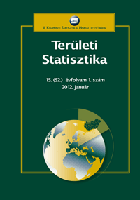A foglalkoztathatóság mérési lehetőségei és térszerkezete Magyarországon
The Spatial Structure and Measurement of Employability
in Hungary
Author(s): Levente Alpek, Róbert TésitsSubject(s): Social Sciences, Economy, Geography, Regional studies
Published by: Központi Statisztikai Hivatal
Keywords: employability; labor market; qualification; economic activity
Summary/Abstract: The core of this study is to implement a statistical tool for measuring employability and identify its main functional factors using a theoretical model based on literary experience. The E-index explores the main elements of the Hungarian spatial structure and evaluates the territorial differentiation factors. The quantification of employability, beyond the complex indicator, is based on three more subdivisions: the quality of the economic and social environment and their relationship, the balance of supply and demand. The settlement types were identified by cluster analysis, the spatial "hot spots" and"cold spots" were localized using Getis–Ord's G*statistics. The analysis revealed that the spatial structure of employability, though similar in some respects to the pattern outlined by the unemployment rate, shows significant differences from several points. The difference can be clearly seen in both macro and microstructures. In a microstructural view, if the labor market situation is more favorable than employability, it is often resulted by the spatial proximity of a city with prominent economic indicators. Typically, the more accessible a job center, themore it is able to generate higher employment than what could be deduced from the level of employability. At the same time, high employability and potentially exploitable workforce is conceivable even inunfavorable labor market areas.
Journal: Területi Statisztika
- Issue Year: 59/2019
- Issue No: 02
- Page Range: 164-187
- Page Count: 24
- Language: Hungarian

